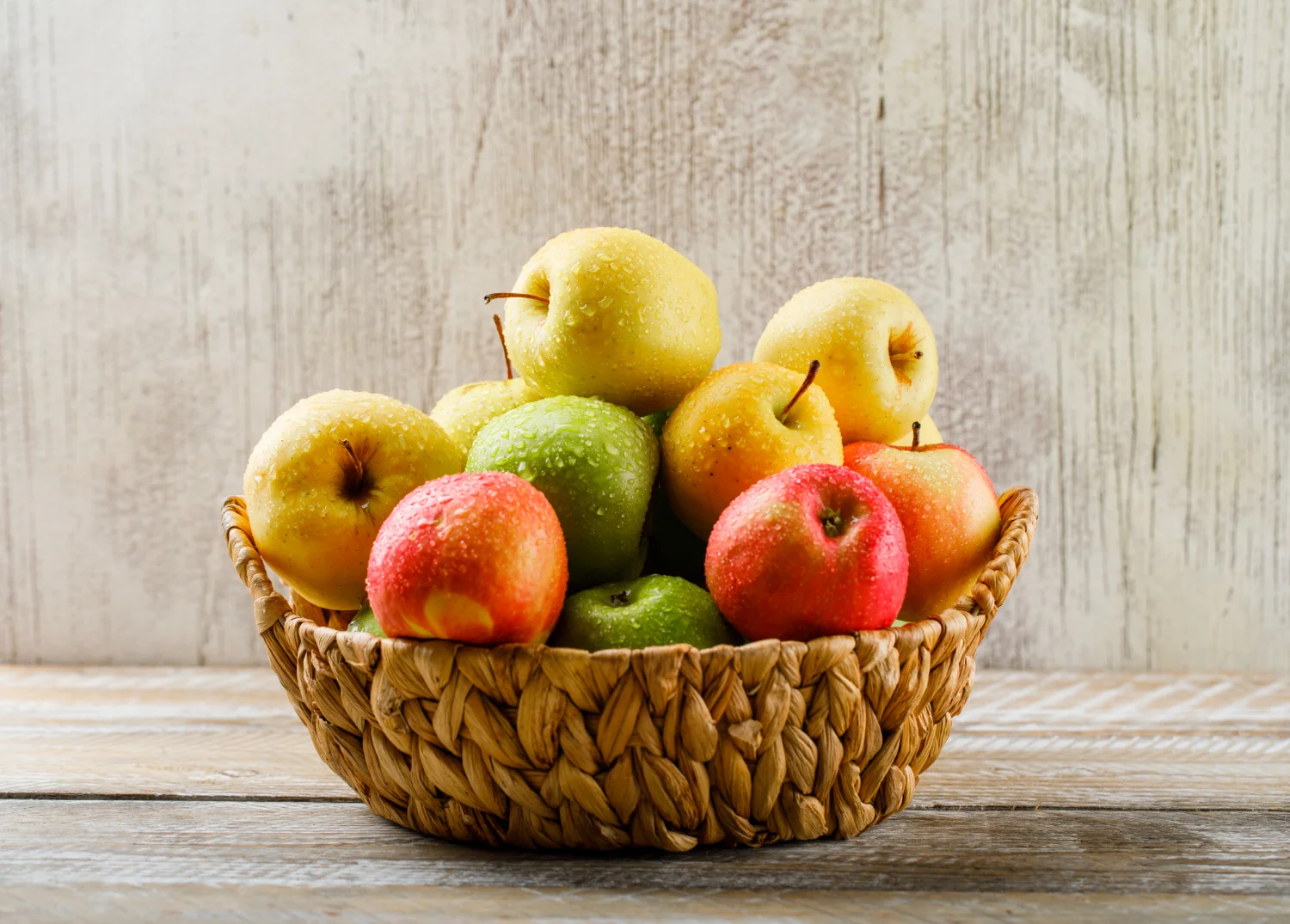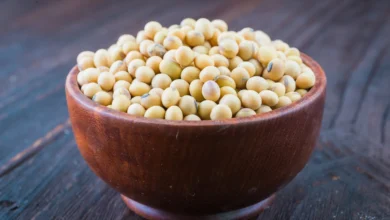Sweetest Apples Ranked: Your Ultimate Guide from Sweet to Tart
Imagine an apple so sweet, it rivals your favorite candy. Or one so juicy, it bursts with flavor in every bite. Welcome to the world of sweet apples, a natural candy aisle brimming with options to tantalize your taste buds.
Leading the charge is the Honeycrisp, a modern marvel of apple breeding. Each bite delivers an explosion of sugary-sweet juice, a symphony of flavors that dances across your palate. But this apple isn’t just about sweetness – its crisp texture adds a satisfying crunch, making it a versatile ingredient for everything from salads to desserts.
For those seeking a more delicate sweetness, the Ambrosia apple beckons. Its creamy texture melts in your mouth, while its subtle sweetness lingers long after the last bite. Whether enjoyed fresh from the tree or baked into a warm pie, the Ambrosia is a testament to the nuanced flavors that nature can offer.
Contents
- Sweetest Apples
- What is the Sweetest Apple?
- Apple Sweetness and Usage Guide
- Apple Sugar Content Guide
- A Guide to Apples From Tart to Sweet
- Exploring the World of Apple-Derived Delights
- Perfectly Balanced: Sweet and Tart Apples
- Recipes to Make with Sweet Apples
- Perfect Pairings: Elevating the Apple Experience
- Mastering Apple Storage: Tips and Tricks for Long-Lasting Freshness
- Apple Picking Pro Tips: Selecting the Perfect Fruit
- Where to Find Your Favorite Apples
- Apple Substitution Guide
- An Apple a Day: Unveiling the Health Benefits
- Apple Glossary: Decoding the Language of Apples
- Apple Varieties Around the World: A Global Tour of Flavor
- Frequently Asked Questions
Sweetest Apples
Of course, no list of sweetest apples would be complete without the classic Fuji. Its balanced sweetness and satisfying crunch make it a versatile fruit that’s equally delicious for baking, slicing, or simply enjoying on its own.
While not as sugary-sweet as some of the other varieties, the Golden Delicious offers a unique sweetness that pairs well with savory flavors. It’s a great choice for those who enjoy a touch of tartness along with their sweetness.
Apple Sweetness Chart
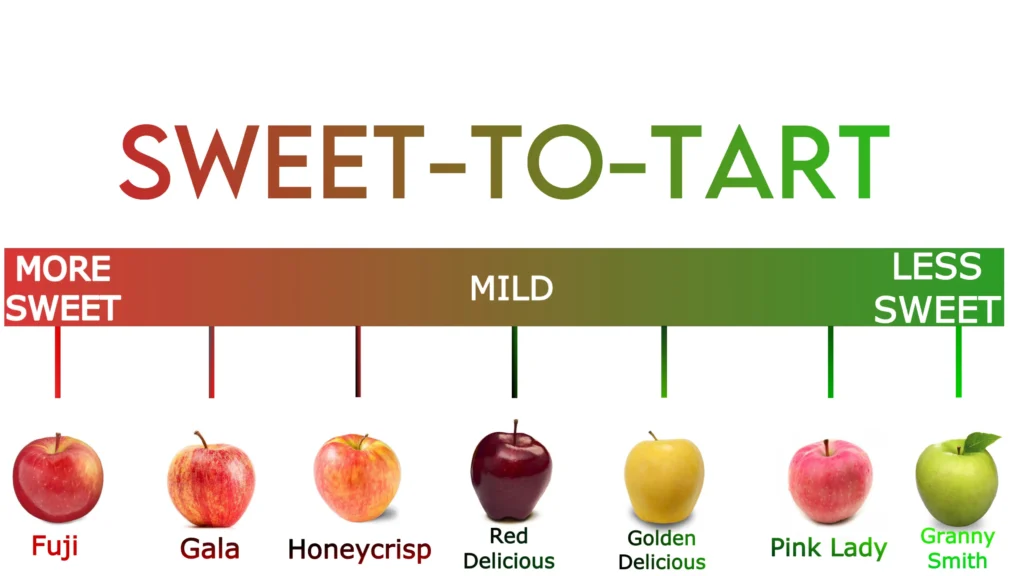

Speaking of tartness, the Granny Smith is a lip-smacking variety that’s known for its bright, acidic flavor. While not traditionally considered a sweet apple, its tangy taste can be a refreshing contrast to sweeter options.
No matter which sweet apple you choose, you’re in for a treat. These nutritious fruits are packed with vitamin C, antioxidants, and fiber, making them a healthy and delicious addition to any diet.
Whether you’re enjoying a fall-filled day at the apple orchard or simply picking up a few apples at the grocery store, there’s a sweet apple out there for everyone. So grab a few varieties, consult an Apple Sweetness Chart, and start exploring easy apple recipes to find your new favorites. With so many delicious options in season, there’s no better time to enjoy the natural sweetness of apples.
What is the Sweetest Apple?
The title of “sweetest apple” is often awarded to the Fuji, with Gala and Honeycrisp as close competitors. These varieties boast a naturally high sugar content, making them the perfect choice for a quick, sugary snack. Red Delicious apples also fall into this category, offering a satisfyingly sweet flavor that’s perfect for eating on its own.
While not as sugary, Granny Smith, McIntosh, and Pink Lady apples have a delightful tartness that adds complexity to their flavor. Their acidity balances well with added sweetness, making them ideal for baking. If you prefer a balance of sweet and tart, Braeburn and Golden Delicious apples offer the best of both worlds, sitting comfortably in the middle of the sweetness spectrum.
Apple Sweetness and Usage Guide
| Type of Apple | Sweetest Level | Best For | Peak-of-Season |
| Fuji | Very Sweet | Snacking, applesauce, baking | Mid to late October |
| Gala | Very Sweet | Snacking, applesauce, baking | Late July to early September |
| Honeycrisp | Sweet | Snacking, salads, baking | September |
| Red Delicious | Sweet | Snacking, salads | Mid to late September |
| SweeTango | Sweet-tart | Snacking, baking, cooking | Late August to September |
| Cosmic Crisp | Balanced Sweet-Tart | Snacking, salads, baking | December |
| Golden Delicious | Mildly Sweet | Snacking, baking, applesauce | Mid to late September |
| Braeburn | Balanced Sweet-Tart | Snacking, salads, baking | October to November |
| Pink Lady | Tart-Sweet | Snacking, salads, baking, pies | Mid to late October |
| McIntosh | Tart | Snacking, baking, cider, applesauce | September to October |
| Granny Smith | Very Tart | Baking, salads, pies | October to November |
Apple Sugar Content Guide
| Type of Apple | Sweetest Level | Sugar Content (grams per 100g) | Best For | Peak-of-Season |
|---|---|---|---|---|
| Fuji | Very Sweet | 15-18 | Snacking, applesauce, baking | Mid to late October |
| Gala | Very Sweet | 14-16 | Snacking, applesauce, baking | Late July to early September |
| Honeycrisp | Sweet | 13-15 | Snacking, salads, baking | September |
| Red Delicious | Sweet | 10-14 | Snacking, salads | Mid to late September |
| SweeTango | Sweet-tart | 12-14 | Snacking, baking, cooking | Late August to September |
| Cosmic Crisp | Balanced Sweet-Tart | 12-14 | Snacking, salads, baking | December |
| Golden Delicious | Mildly Sweet | 10-12 | Snacking, baking, applesauce | Mid to late September |
| Braeburn | Balanced Sweet-Tart | 10-12 | Snacking, salads, baking | October to November |
| Pink Lady | Tart-Sweet | 9-11 | Snacking, salads, baking, pies | Mid to late October |
| McIntosh | Tart | 8-10 | Snacking, baking, cider, applesauce | September to October |
| Granny Smith | Very Tart | 6-8 | Baking, salads, pies | October to November |
A Guide to Apples From Tart to Sweet
Granny Smith
These vibrant green orbs are the epitome of tartness, a flavor profile that has made them a culinary mainstay for over a century. Bred in Australia by Maria Ann Smith in the late 1800s, Granny Smiths offer a crisp, juicy bite that invigorates the palate. While their bold tartness may not be for everyone as a standalone snack, it’s precisely this quality that makes them shine in the culinary world.
Their high acidity balances out the sweetness in pies and crumbles, ensuring a complex and satisfying flavor experience. Moreover, their firm flesh holds up remarkably well under heat, making them the perfect choice for baked goods that retain their structure and texture.
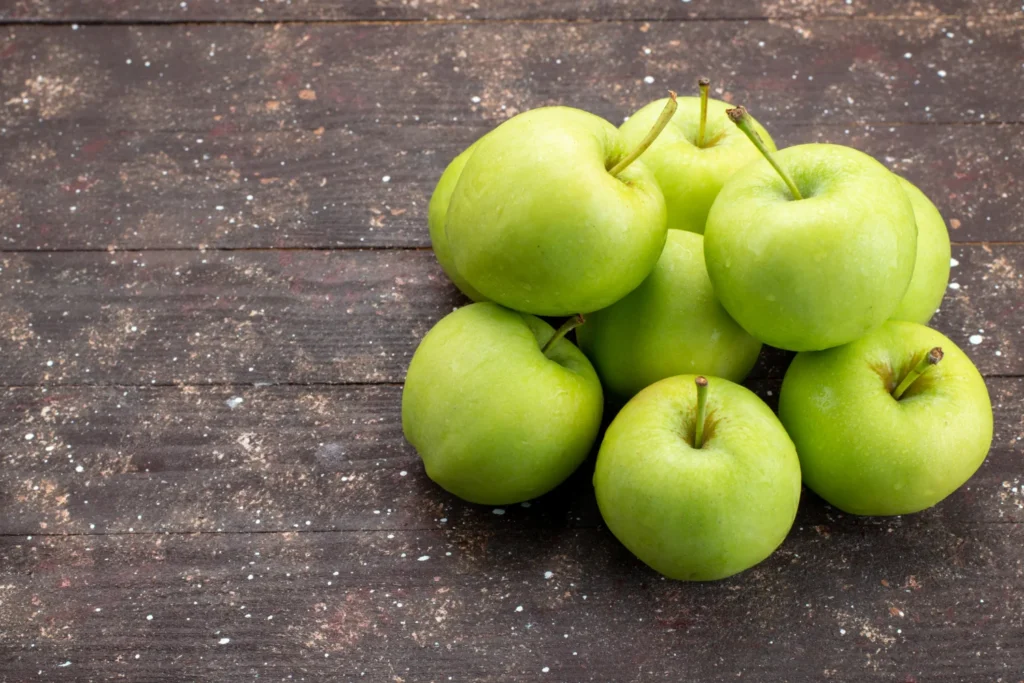

McIntosh
A Canadian icon, the McIntosh apple has captured the hearts of apple lovers for generations. With its signature mottled red-green skin and tender, juicy flesh, it strikes a delightful balance between sweet and tart. While enjoyable on its own, its true potential is unleashed when transformed into cider, juice, or applesauce.
The McIntosh’s ability to maintain its shape during cooking also makes it a reliable choice for pies and baked goods, adding a subtle tartness that complements other flavors.


Pink Lady
The Pink Lady is a relative newcomer to the apple scene, but it has quickly garnered a devoted following for its striking appearance and unique flavor profile. Developed in Australia in the 1970s, this apple is a cross between Golden Delicious and Lady Williams varieties. Its blush-pink skin hints at the sweet-tart flavor within, while its firm, crisp texture adds a satisfying crunch.
Pink Ladies are exceptionally versatile, shining in salads, snacks, and desserts alike. Their complex flavor profile, a harmonious blend of sweet, tart, and floral notes, elevates any dish they grace.
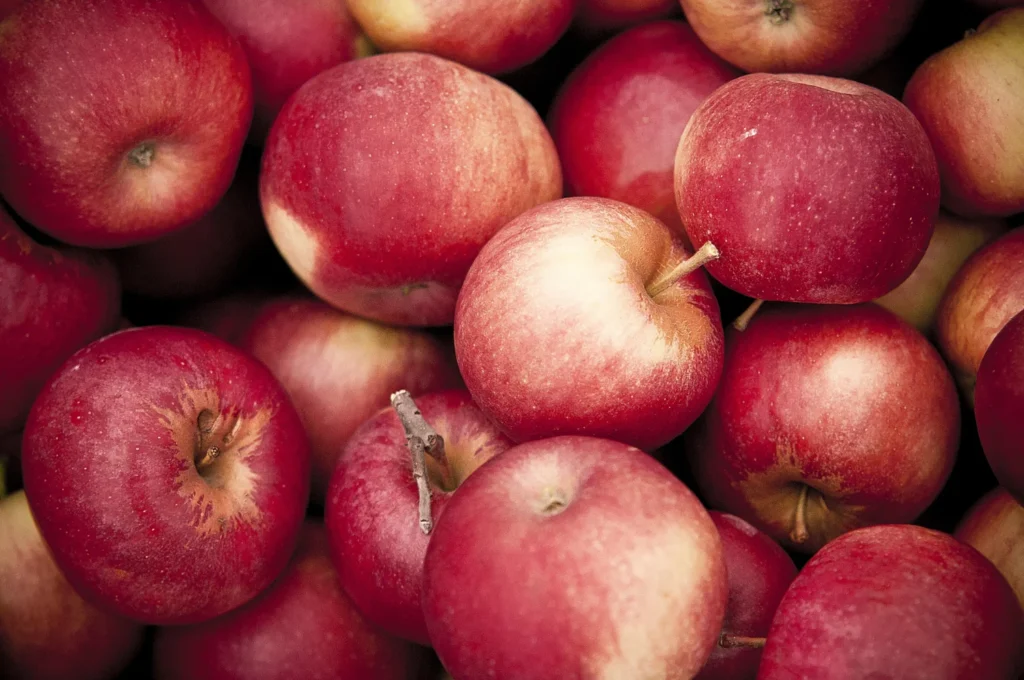

SweeTango
Introduced in 2009 as a cross between the Honeycrisp and Zestar varieties, the SweeTango apple is a modern marvel of flavor. Its name aptly captures its essence: a burst of sweetness with an underlying hint of spice. Its firm, crisp texture makes it a joy to bite into, and its complex flavor profile is a symphony for the taste buds.
Whether enjoyed fresh as a snack, incorporated into baked goods, or even used in savory dishes, the SweeTango never fails to impress.


Golden Delicious
A timeless American favorite, the Golden Delicious apple has been a staple in kitchens across the country for over a century. Its sunny yellow skin encases a tender, sweet flesh with hints of tropical fruit. While it may not be the most complex apple in terms of flavor, its reliability and versatility have made it a go-to choice for both snacking and cooking. Its sweetness and ability to hold its shape make it an excellent candidate for pies, sauces, and other baked goods.
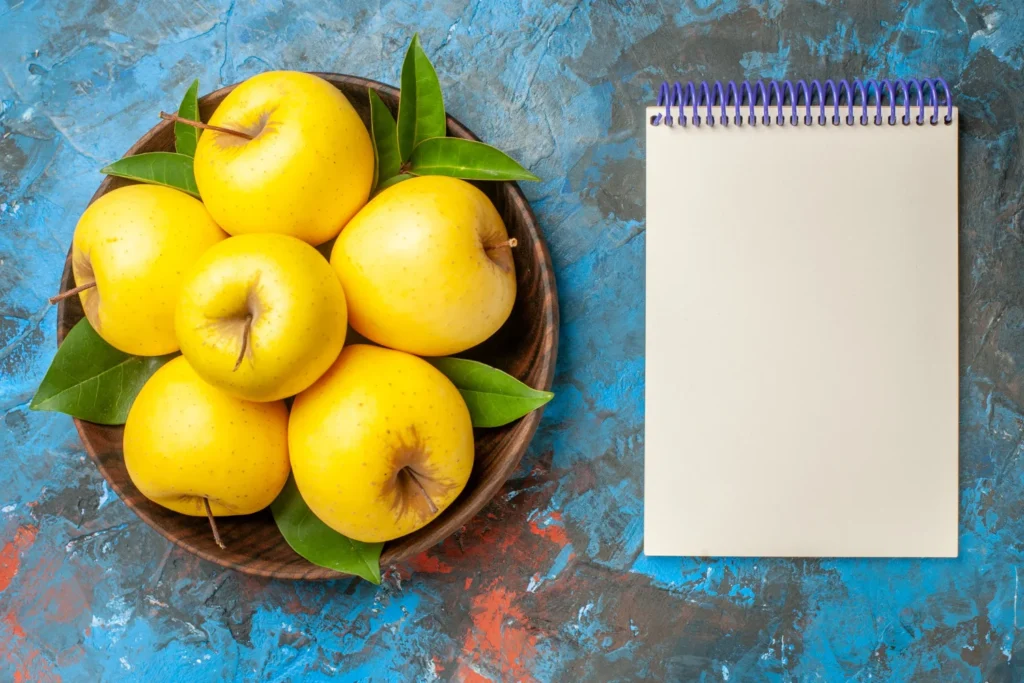

Braeburn
Hailing from New Zealand, Braeburn apples are a visual delight with their mottled skin that ranges from red and yellow to orange and green. But their beauty is more than skin deep. Their flavor, a complex blend of sweet and tart with hints of spice and nutmeg, is equally captivating.
Their firm, dense flesh adds a satisfying crunch to salads and sandwiches, while their ability to retain their flavor and texture during cooking makes them a valuable addition to pies and other baked goods.
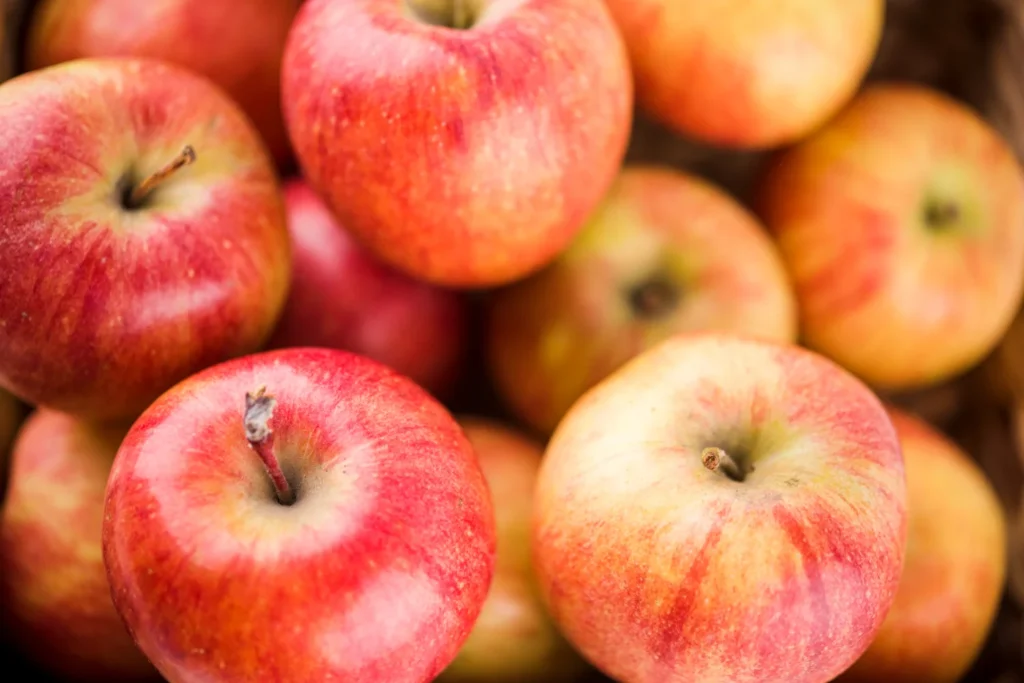

Red Delicious
The Red Delicious apple, with its deep red skin and iconic shape, is perhaps one of the most recognizable apple varieties in the world. However, it has become somewhat controversial in recent years due to its focus on sweetness over complexity.
While its intensely sweet flavor and soft texture may appeal to some, others find it lacking in depth and acidity. Nevertheless, it remains a popular choice for snacking and salads, where its sweetness can be balanced by other ingredients.
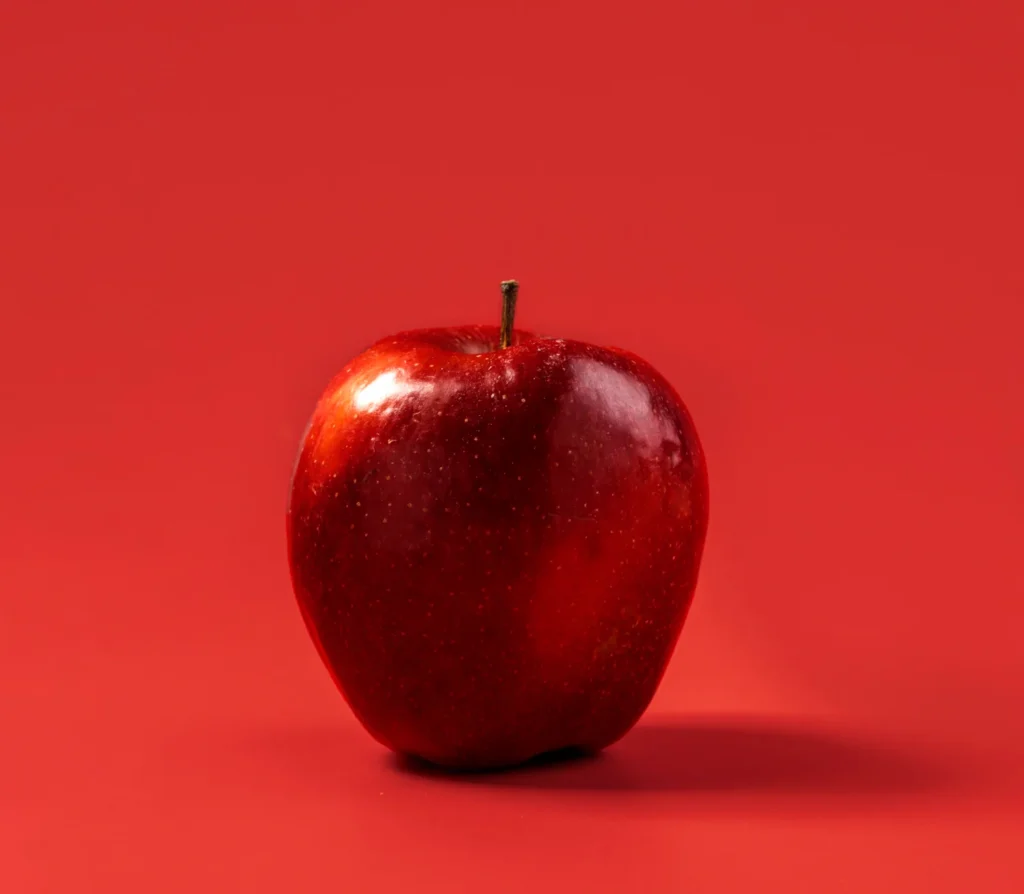

Honeycrisp
A true game-changer in the apple world, the Honeycrisp apple redefined what it meant to be juicy. Developed at the University of Minnesota in the 1960s, this apple boasts an explosive burst of juice with every bite, coupled with a perfect balance of sweet and tart flavors.
Its unique texture, a combination of crispness and tenderness, has captivated apple enthusiasts worldwide. While undeniably delicious on its own, the Honeycrisp also shines in juices and desserts, where its sweetness and juiciness add a delightful dimension.
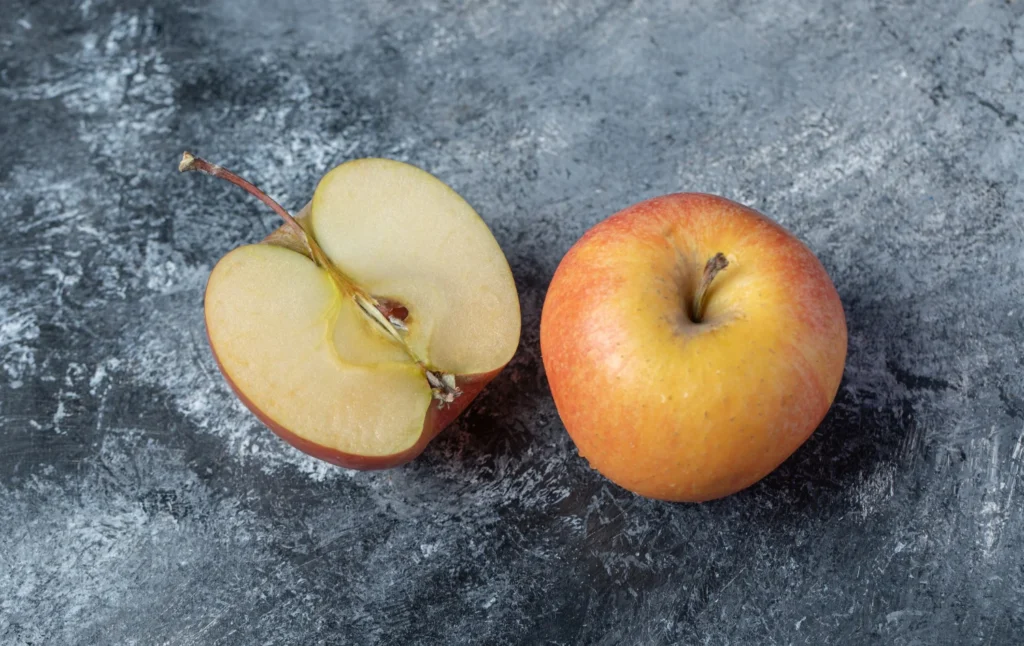

Gala
The Gala apple, a cross between Golden Delicious and Kidd’s Orange Red, has become one of the most popular apple varieties in the world for good reason. Its sweet, slightly floral flavor and crisp, firm texture make it a crowd-pleaser.
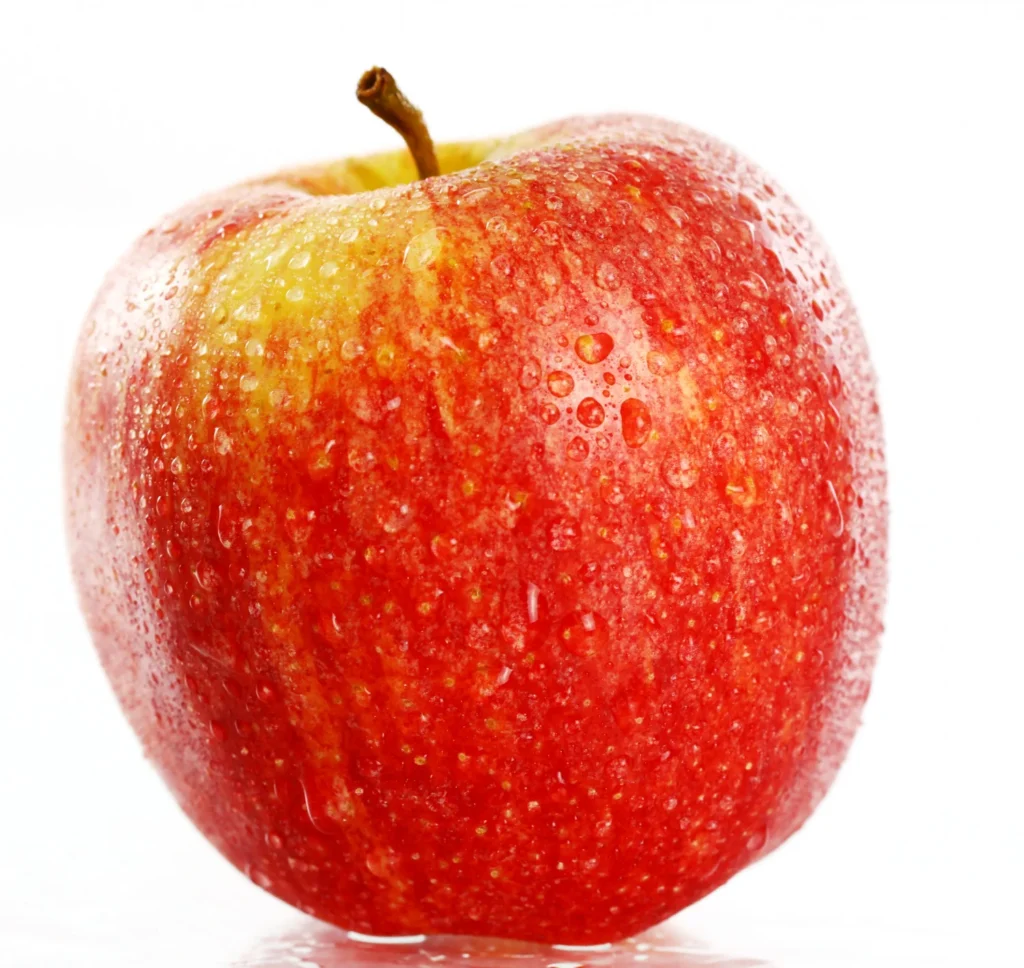

Fuji
A Japanese import, the Fuji apple has taken the American market by storm. Its exceptionally sweet flavor, often compared to honey, combined with its firm, crisp texture, has made it a favorite among apple lovers. Whether you enjoy it fresh, baked into a pie, or incorporated into a savory dish, the Fuji apple is sure to delight.
This updated guide provides a more in-depth and nuanced look at each apple variety, drawing on the latest information and trends in the world of apples. By highlighting the unique characteristics of each variety and suggesting culinary uses, it aims to empower readers to make informed choices and explore the wide world of apples.
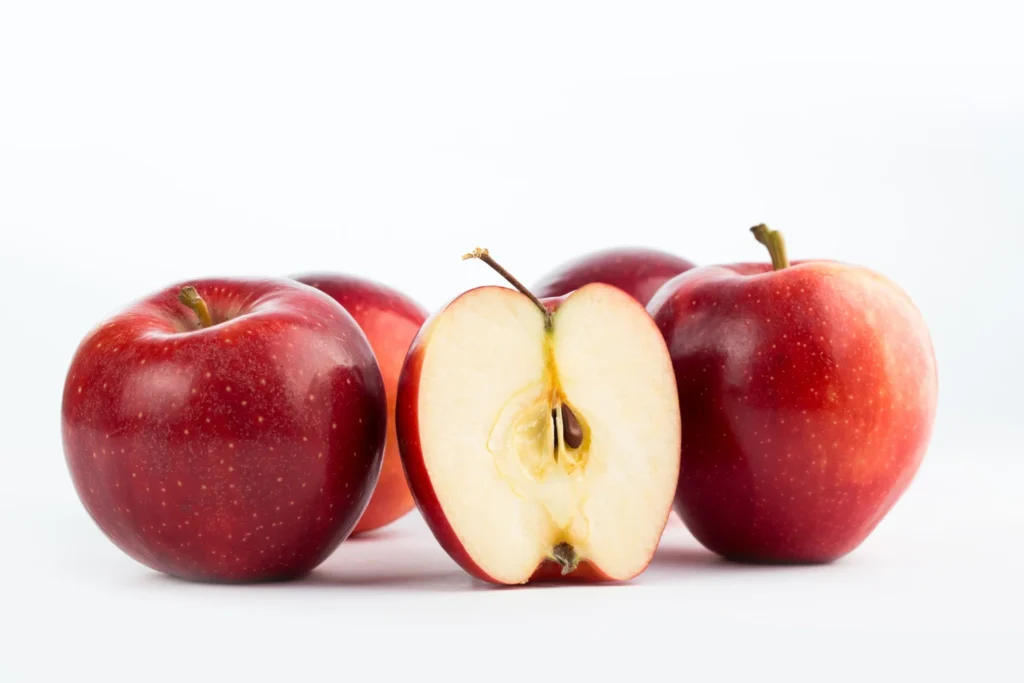

Exploring the World of Apple-Derived Delights
While biting into a crisp, juicy apple is a pleasure in itself, the culinary world offers a delightful array of products crafted from this humble fruit. These creations not only showcase the versatility of apples but also provide unique ways to enjoy their flavors and nutritional benefits.
Apple Cider Vinegar: This fermented elixir has been a kitchen staple for centuries, renowned for its tangy flavor and potential health benefits. From salad dressings to marinades, its uses are as varied as the apple varieties it’s derived from. Modern research suggests it may even aid in digestion and blood sugar control.
Apple Butter: A slow-cooked, concentrated apple sauce, apple butter is a labor of love that rewards with a rich, complex flavor and a velvety smooth texture. Perfect on toast, swirled into yogurt, or used as a glaze for meats, apple butter captures the essence of autumn in a jar.
Apple Brandy (Calvados): This distilled spirit, hailing from the Normandy region of France, is a testament to the apple’s ability to transform into a sophisticated beverage. Aged in oak barrels, Calvados boasts a complex flavor profile with notes of apple, spice, and wood. Sipped neat or used in cocktails, it’s a warming indulgence for the colder months.
Hard Apple Cider: A fizzy, fermented beverage, hard apple cider offers a refreshing alternative to beer and wine. With a wide range of styles, from dry and tart to sweet and sparkling, there’s a cider to suit every palate. Modern cider makers are experimenting with different apple varieties and fermentation techniques, resulting in a vibrant and ever-evolving landscape of flavors.
Apple Cider Donuts: A fall favorite, these cake-like donuts are infused with the warm spices of apple cider and often coated in cinnamon sugar. Whether enjoyed fresh from the fryer or as a sweet treat with a cup of coffee, apple cider donuts are a nostalgic reminder of the season.
These are just a few examples of the many delicious and innovative products that have been crafted from apples. As you explore the world of apples, consider venturing beyond the fruit bowl and discovering the exciting possibilities that await in the realm of apple-derived delights.
Perfectly Balanced: Sweet and Tart Apples
Cosmic Crisp
The Cosmic Crisp® apple, often referred to as the “dream apple,” boasts a perfect sweet to tart ratio and an out-of-this-world flavor. As a cross between the Honeycrisp and Enterprise apple, this super juicy, crisp apple is a must-try for anyone seeking a balanced flavor experience.
SweeTango
The SweeTango® apple offers the best of both worlds, delivering a sweet yet tangy bite. Experience one of the crunchiest apples available, bursting with juice and vibrant acidity, with notes of fall spices.
Whether you put these apples on an Apple Sweetness Scale or simply choose your favorite, they are sure to be a delightful addition to snacks, baked goods, and smoothies. From the tartest Granny Smith to the sweetest Fuji apple, there’s a variety for everyone to enjoy.
Recipes to Make with Sweet Apples
Sweet apple recipes bring out the natural sweetness of apples and combine them with delicious ingredients for a mouth-watering dish. Here are a few to explore:
- Autumn Caramel Apple Cookies: These cookies combine the sweetness of caramel with the tartness of apples, making them a perfect autumn treat.
- Candy Apples: A classic treat for Halloween, candy apples take sweet apples and coat them in a hard candy shell.
- Instant Pot Apple Butter: Use your Instant Pot to create creamy, sweet, and tangy apple butter, perfect for spreading on toast or adding to your favorite dessert.
- Instant Pot Cinnamon Apples: These cinnamon apples are a quick and easy dessert that you can make in your Instant Pot to satisfy your sweet tooth.
- Instant Pot Apple Cider: Enjoy the flavors of fall with homemade apple cider made in your Instant Pot.
- Apple Crumble Cheesecake: This unique and delicious dessert combines the creaminess of cheesecake with the sweetness of apple crumble.
READ: Apple and White Chocolate Scones
Perfect Pairings: Elevating the Apple Experience
Apples are incredibly versatile, and their flavors can be enhanced when paired with the right companions. Here are some delicious pairing suggestions:
Cheese:
- Sharp Cheddar: The sharpness of cheddar cheese beautifully complements the sweetness of apples like Fuji or Honeycrisp.
- Brie: The creamy, buttery notes of brie pair well with the tartness of Granny Smith apples.
- Goat Cheese: The tangy flavor of goat cheese contrasts nicely with the sweetness of Honeycrisp or Ambrosia apples. Check out the Apple and Goat Cheese Salad.
Wine:
- Sweet Apples (Fuji, Gala, Honeycrisp): Pair with Moscato, Riesling, or Gewürztraminer.
- Tart Apples (Granny Smith, McIntosh): Pair with Pinot Grigio, Sauvignon Blanc, or Chardonnay.
- Balanced Apples (Braeburn, Golden Delicious): Pair with Rosé, Pinot Noir, or Zinfandel.
Other Foods:
- Caramel: The classic combination of caramel and apples is always a winner, especially with sweeter varieties like Honeycrisp.
- Nuts: Almonds, walnuts, and pecans add a satisfying crunch and complement the sweetness of apples.
- Pork: The sweetness of apples pairs surprisingly well with the savory flavors of pork dishes, such as roast pork or pork chops.
- Cinnamon: The warm spice of cinnamon enhances the natural sweetness of apples in desserts like apple pie or apple crumble.
Mastering Apple Storage: Tips and Tricks for Long-Lasting Freshness
Properly storing your apples can dramatically extend their shelf life and preserve their delicious flavor and crispness. Here are some tried-and-true methods, as well as some lesser-known hacks, to ensure your apples stay fresh:
Refrigerator Fundamentals:
- Cold is Key: Apples thrive in cool temperatures, ideally between 30°F and 40°F (-1°C and 4°C). The refrigerator’s crisper drawer is usually the best spot.
- Breathable Containers: Opt for perforated plastic bags or ventilated containers to allow for air circulation and prevent moisture buildup.
- Ethylene Separation: Keep apples away from ethylene-producing fruits like bananas and avocados, as this gas can accelerate ripening.
Beyond the Fridge: Clever Storage Hacks:
- The Potato Partnership: Storing apples alongside potatoes in a cool, dark place can be mutually beneficial. Potatoes release moisture that helps maintain apple humidity, while apples emit ethylene gas that can inhibit potato sprouting.
- Newspaper Wraps: Wrap individual apples in newspaper to create a protective barrier against moisture and ethylene gas, slowing down the ripening process and extending their shelf life.
- Vinegar Bath: A brief soak in diluted vinegar (1 part vinegar to 10 parts water) can help remove potential spoilage agents from the apple’s surface. Rinse thoroughly afterwards.
- Cool, Dark Havens: If refrigeration isn’t possible, store apples in a cool, dark, and well-ventilated area like a basement or root cellar.
- Delay the Wash: Apples have a natural wax coating that protects them. Delay washing until just before consuming to preserve this protective layer.
- Separate by Variety: Different apple varieties produce varying amounts of ethylene gas. Store high-ethylene producers (like McIntosh and Braeburn) separately from low-ethylene producers (like Granny Smith and Fuji) to avoid premature ripening.
- Freezing for the Future: For long-term storage, freeze sliced apples (tossed in lemon juice to prevent browning) in airtight containers or freezer bags for up to six months.
By implementing these storage strategies, you can ensure that your apples remain crisp, juicy, and flavorful for weeks or even months, so you can savor their deliciousness throughout the season.
Apple Picking Pro Tips: Selecting the Perfect Fruit
Whether you’re venturing to a local orchard or browsing the produce aisle, these tips will help you choose the best apples:
Specific Variety Tips:
- Honeycrisp: Look for a bright red or yellow background with streaks of red.
- Fuji: Choose apples with a deep red or yellow blush over a yellow-green background.
- Gala: Select apples with a bright orange-red color and stripes.
- Granny Smith: Opt for bright green apples with smooth skin.
- Golden Delicious: Look for apples with a golden yellow color and slight russeting.
Color:
- Look for apples with vibrant, consistent color for their variety. Avoid those with dull or faded hues.
- Slight variations in color can be normal, but watch for large brown spots or bruises, which indicate damage.
Texture:
- Gently press the apple’s skin. It should feel firm and smooth, not soft, mushy, or wrinkled.
- Avoid apples with punctures, cuts, or other signs of damage.
Firmness:
- A ripe apple should feel slightly firm to the touch, with a little give when gently squeezed.
- Avoid overly soft apples, as they may be overripe or mealy.
Stem:
- Choose apples with their stems intact. A missing stem can be a sign of damage or improper handling.
Aroma:
- Give the apple a sniff. A ripe apple should have a sweet, pleasant fragrance. Avoid apples with a fermented or vinegar-like smell.
Where to Find Your Favorite Apples
While some apple varieties are widely available year-round, others have a more limited seasonality. Here’s where you can typically find the apples mentioned in this guide:
Grocery Stores:
- Fuji: Widely available in most grocery stores throughout the year.
- Gala: Readily available in most grocery stores year-round.
- Honeycrisp: Usually available from late summer through winter.
- Red Delicious: Commonly found in grocery stores year-round.
- Golden Delicious: Widely available in most grocery stores throughout the year.
- Granny Smith: Commonly found in grocery stores year-round.
Farmers Markets:
- SweeTango: Often found at farmers markets during their peak season in late summer and early fall.
- Cosmic Crisp: Typically available at farmers markets in the winter months.
- Braeburn: Can be found at farmers markets in the fall.
- Pink Lady: May be available at farmers markets in the fall and winter.
- McIntosh: Often found at farmers markets during their peak season in the fall.
Online Retailers:
- Many apple varieties, including those mentioned in this guide, can be purchased online from specialty retailers or directly from orchards during their respective seasons.
Remember: The availability can vary depending on your location and the time of year.
Apple Substitution Guide
| If the Recipe Calls For… | Try Substituting… | Notes |
|---|---|---|
| Very Sweet Apples (Fuji, Gala) | Honeycrisp, Ambrosia, SweeTango (for a touch of tartness) | These apples offer similar sweetness levels and can be used interchangeably in most recipes. |
| Honeycrisp | Fuji, Gala, Ambrosia, SweeTango | These varieties share Honeycrisp’s juicy, crisp texture and sweet flavor profile. |
| Golden Delicious | Braeburn, Jonagold, Crispin (Mutsu) | These apples offer a similar balance of sweet and tart flavors, making them suitable substitutes for Golden Delicious. |
| Braeburn | Golden Delicious, Fuji, Honeycrisp, Pink Lady | These apples can provide a similar sweet-tart balance or lean more towards sweetness, depending on your preference. |
| Granny Smith (Very Tart) | McIntosh, Pink Lady, Braeburn (for less tartness) | These tart apples are good substitutes for Granny Smith, but Braeburn offers a slightly milder flavor. |
READ: Apple Banana Smoothie
An Apple a Day: Unveiling the Health Benefits
Beyond their delicious taste, apples offer a wealth of health benefits, thanks to their rich nutritional profile.
Vitamins and Minerals:
- Vitamin C: A powerful antioxidant that boosts the immune system, protects against cell damage, and aids in collagen production for healthy skin and joints.
- Potassium: An essential mineral that helps regulate blood pressure, supports muscle function, and maintains healthy nerve transmission.
- Vitamin K: Crucial for blood clotting and bone health.
Fiber:
- Soluble Fiber: This type of fiber forms a gel-like substance in the gut, promoting digestive health, lowering cholesterol levels, and regulating blood sugar.
- Insoluble Fiber: This type of fiber adds bulk to the stool, preventing constipation and promoting regular bowel movements.
Antioxidants:
- Quercetin: A flavonoid with anti-inflammatory properties that may protect against heart disease, cancer, and neurodegenerative diseases.
- Catechin: Another flavonoid with antioxidant and anti-inflammatory effects, linked to improved heart health and cognitive function.
- Chlorogenic Acid: This polyphenol compound has been shown to help regulate blood sugar levels and reduce the risk of type 2 diabetes.
In addition to these specific nutrients, apples also contain other beneficial compounds like pectin, a type of soluble fiber that acts as a prebiotic, nourishing the beneficial bacteria in the gut.
Regularly enjoying apples as part of a balanced diet can contribute to overall health and well-being, supporting heart health, gut health, immune function, and even weight management due to their high fiber content. So next time you reach for a snack, consider grabbing an apple and reaping the rewards of its nutritional bounty.
Apple Glossary: Decoding the Language of Apples
- Apple Varieties: The many different types of apples, each with unique characteristics like flavor, texture, and appearance (e.g., Fuji, Honeycrisp, Granny Smith).
- Antioxidants: Naturally occurring compounds in apples that help protect cells from damage caused by harmful molecules.
- Blemish: A mark or imperfection on the skin of an apple, usually caused by insect damage, disease, or rough handling.
- Crisp: A term used to describe the texture of an apple that is firm and breaks with a snap when bitten into.
- Ethylene Gas: A natural plant hormone that accelerates the ripening process of fruits, including apples.
- Firmness: The degree of hardness or softness of an apple’s flesh.
- Flavonoids: A group of plant compounds found in apples with antioxidant and anti-inflammatory properties.
- Juice: The liquid extracted from apples, often used for drinking, cooking, or making cider.
- Mealy: A texture that describes an apple that is dry, soft, and crumbly.
- Pectin: A soluble fiber found in apples that contributes to their texture and can be used to thicken jams and jellies.
- Pectic Enzymes: Enzymes found in apples that break down pectin, causing the fruit to soften as it ripens.
- Russeting: A rough, brown, net-like pattern on the skin of some apples, caused by corky tissue.
- Tart: A flavor that is sharp, acidic, and tangy.
- Variety: A specific type of apple with distinct characteristics (e.g., Gala, Honeycrisp).
- Watercore: A physiological disorder in apples that causes translucent, water-soaked areas in the flesh.
Understanding these terms can help you navigate apple recipes, descriptions, and discussions with confidence, allowing you to fully appreciate the diverse world of apples.
Apple Varieties Around the World: A Global Tour of Flavor
Beyond the common varieties found in supermarkets, a vast world of unique and exotic apples awaits discovery. These apples, cultivated in different corners of the globe, offer a diverse range of flavors, colors, and textures.
Asia:
- Fuji (Japan): A cross between Red Delicious and Ralls Janet, Fuji apples are known for their sweet flavor and firm texture. They’re widely cultivated in Japan and other parts of Asia, and have become one of the most popular apple varieties worldwide.
- Sekai Ichi (Japan): Meaning “world’s number one” in Japanese, this aptly named apple is the largest apple variety in the world. It can grow up to the size of a grapefruit and boasts a sweet, juicy flavor.
- Black Diamond (Tibet): Grown in the Tibetan Plateau, this rare apple variety is known for its striking deep purple skin and white flesh. Its flavor is said to be sweet and slightly tart, with hints of grape.
Europe:
- Cox’s Orange Pippin (England): A classic English apple with a complex flavor profile that balances sweetness with acidity and a hint of spice. It’s considered a connoisseur’s apple and is prized for its exceptional taste.
- Bramley (England): This cooking apple is known for its high acidity and firm texture, making it ideal for pies, crumbles, and other baked goods.
- Pinova (Germany): A cross between Golden Delicious and Cox’s Orange Pippin, this apple boasts a sweet, aromatic flavor and juicy flesh. It’s a popular choice for snacking and desserts.
North America:
- Honeycrisp (USA): Developed at the University of Minnesota, this apple variety is prized for its explosive juiciness, balanced sweetness, and crisp texture.
- Cosmic Crisp (USA): A relatively new variety, the Cosmic Crisp is a cross between Honeycrisp and Enterprise. It’s known for its exceptional storage life, maintaining its crispness and flavor for months.
- Arkansas Black (USA): This heirloom apple variety has a deep red, almost black skin and firm, crisp flesh. Its flavor is complex and rich, with notes of spice and honey.
Conclusion
Whether you’re a fan of the classic sweetness of a Fuji or the invigorating tartness of a Granny Smith, the world of apples offers a flavor adventure for every palate. From the bustling markets of Japan to the rolling hills of England, unique apple varieties thrive, each with its own story to tell. As you explore these diverse flavors and textures, you’ll discover that the humble apple is anything but ordinary. So, the next time you bite into an apple, savor the rich history and global journey that brought it to your hand.
______________________________
Frequently Asked Questions
What is the sweetest type of apple?
According to most apple sweetness charts, the Fuji apple consistently ranks as one of the sweetest, with high sugar levels inherited from its parents, the Red Delicious and Virginia Ralls Janet.
Are green apples sweet?
Green apples are typically known for their sour taste, due to their thick skin and higher acidity levels. However, some green apple varieties, like Pippin, can have a subtle sweetness. Red apples are generally considered sweeter and juicier, with a thinner skin, but sweetness preferences are subjective.
Are Jazz apples sweet?
Jazz apples are a crisp, hard apple with an excellent, strong sweet-sharp flavor and a pronounced, fruity, pear-drop note. While not the sweetest, they often rank first in taste tests compared to traditional varieties like Pink Lady or Braeburn.
What is the sourest apple?
The Granny Smith apple variety is unique in the apple world for its vibrant green color and intensely sour taste. It’s often considered the exact counterpart to the Golden Delicious apple in terms of flavor profile.
What are some other sweet apple varieties to try?
Besides the popular Fuji, Gala, and Honeycrisp, you might also enjoy Ambrosia, Pink Lady, or SweeTango apples for a deliciously sweet treat.
Are there health benefits to eating sweet apples?
Yes! Sweet apples are packed with nutrients like fiber, vitamin C, and antioxidants, which can help boost your immune system, improve digestion, and even protect against certain diseases.
Can I use sweet apples for baking?
Absolutely! While tart apples are often preferred for baking due to their ability to hold their shape, sweet apples can also be used, especially in recipes that call for additional sugar or spices.
How can I tell if an apple is sweet without tasting it?
While the best way to judge an apple’s sweetness is to taste it, you can get a general idea by its color and texture. Apples with a deeper red or yellow hue tend to be sweeter, while those with a green or blush color are usually more tart. Additionally, apples with a softer texture may be riper and sweeter than those with a firm texture.

